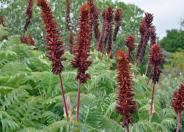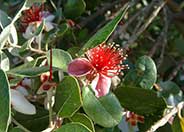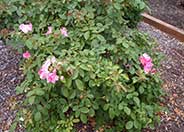
Common name:Honey Bush
Botanical name:Melianthus major
Melianthus major is an evergreen shrub. It is a soft-wooded plant of rapid growth to 12'-14'. It has a boldly patterned foliage with grayish green leaves of 1' long, divided into 9-11 strongly toothed leaflets. Foliage smells disagreeable when brushed or bruised. Foot-long spikes of reddish brown, 1" flowers appear in late winter, early spring.

Common name:Pineapple Guava, Feijoa
Botanical name:Feijoa sellowiana
Classified as an evergreen shrub or a small tree, this plant can be pruned to almost any size or shape. Its foliage is gray-green and silvery underneath. White flowers with bright red stamens can be seen, followed by 1-4" long, oval, edibl fruit. Full sun is required for proper growth.

Common name:Mexican Bush Sage, Velvet Sage
Botanical name:Salvia leucantha
The Mexican Sage is a bushy shrub that grows 3'-4' tall and wide. It has hairy white stems, gray green leaves and velvet-like purple flower spikes that bloom summer through fall. This shrub tolerates sun, light shade, little water, and is hardy to 15 degrees F. The Mexican Sage is drought tolerant and attracts hummingbirds. -Cornflower Farms

Common name:Ruby Glow Manuka Tea Tree
Botanical name:Leptospermum scoparium 'Ruby Glow'
Ruby Glow Manuka has small, needle-like, green leaves with showy, 1/2" rose-like flowers in winter and spring. These shrubs can be thinned to enhance their attractive branch structure and flaking bark. They need very little water once established. 'Ruby Glow' is compact, upright and grows 6'-8' tall by 4'-5' wide. It has dark foliage with deep red blooms; it works well as a red accent in the garden.

Common name:Shrub Rose
Botanical name:Rosa Shrub varieties
The dark green, heavily veined leaves of this bushy shrub are strong support for the pure white or pink, nearly double flowers it produces. This is a very tolerant, heavily scented plant with an impressive fall color. Also, large hips appear intermittently with this plant.
Photographer: GardenSoft
Practice grass-cycling by leaving short grass clippings on lawns after mowing, so that nutrients and organic matter are returned to the soil.
Remove irrigation water and fertilizer from areas where you don't want weeds to grow.